
|   |

|   |
 e-mail: ukb7@rediffmail.com Evolution of dance - over aeons, everywhere Photos courtesy: Mahagami June 7, 2022 Dance has generally been recognized by the cognoscente as an embodiment of the rhythmic, harmonic and aesthetic expressions that man could achieve in his relationship with himself and with the wide open world since the very time of Creation. Indeed, once the arboreal monkeys came down on the solid ground on their two feet and liberated hands for numerous other functions, they became Homo erectus and could make many gestures and create arbitrary patterns and movements. Generations later evolved the Homo sapiens - that is, the modern we - with our all-embracive cultural heritage, including that of dance. [Some scientists have also predicted that we are evolving now into Homo Deus (God-like beings), with our manifold enhancement of thinking power by connecting computers to our brains through information technology as well as enhancing our physical prowess and resistance to all diseases through highly superior biotechnology. One wonders if these would include evolution of a Meta-verse of arts with Artificial Intelligence and Machine Learning (AI/ML), and create a new kind of Virtual Reality and Augmented Reality (VR/AR) where new dance movements could be created and seen in an immersive technology, as are already being done for style designs!] 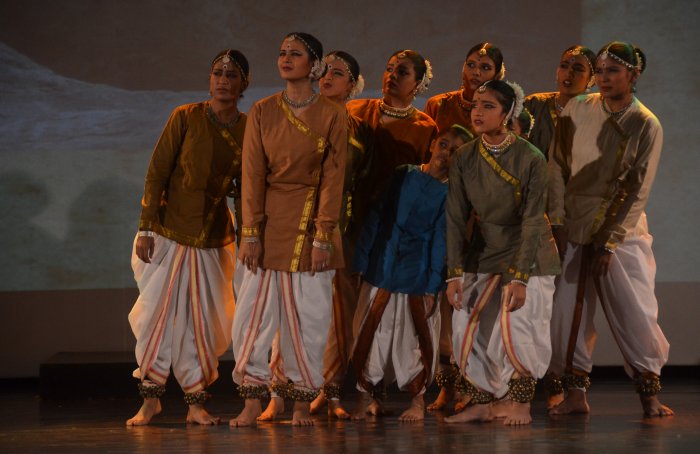 Early man Dance 360 Degrees: Sarvatra Nritya, an ambitious programme, presented by Mahagami University, Performing Arts Department, on the World Dace Day (April 29), offers a unique comprehensive vision into the origin of dance. Conceived and directed by their gifted Dean, Parwati Dutta, the curtain-raiser, Scene 1, finds the bemused dancers observing every activity of Nature with curiosity and confusion. It is as though the humans, as the new denizens of earth, are trying to "learn" from every encounter, experience and effort. This is the pre-history of three lakhs years ago: cognition of the five sensory perceptions of Roopa, Rasa, Shabda, Sparsha, Gandha... Dhun-te-ta/dhun-ta... man is daily taken to new discovery, new quest, new questions, new revolutions, new truths. He tries to follow the flow of life, the pace of life, cycle of life by observing animals and birds. It is the life of hunter-gatherers: by collecting as gatherer and consuming the fruits and vegetables; and surviving as a hunter, having observed carnivores living on their prey. There is no language, no source of communication, no script, no shelter, no ability to comprehend any principle of nature. Man tries to observe carefully every movement, every change of seasons, and stars thinking: How do these acts unfold? Who is doing this? Who is the creator, our fosterer? Where do I find him? Scene 2 begins with resonance of ghungroos, heralding rain. Upanishad's verse resounds: Truth lies concealed in a golden mound / so do you, O sun! / Open the entry to that cover / Be visible to me / A devotee who is truthful by nature / in the light of your illuminating grace...Dancers are in a prayerful mood. Then begins the mind boggling circumambulation of the immense universe of knowledge, one by one. 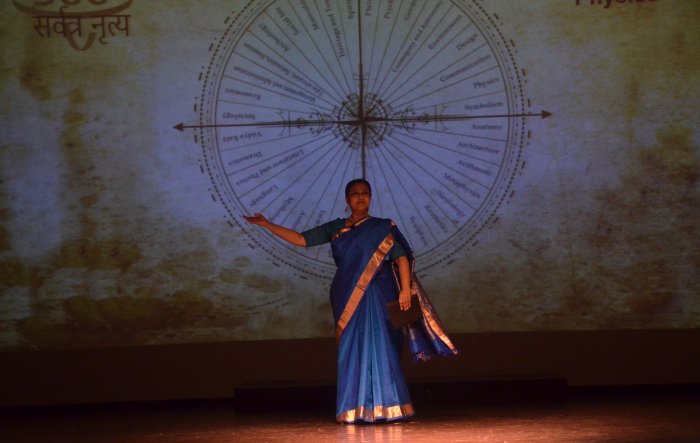 Parwati Dutta "Philosophy" is ushered in first as an inspired narrative, "How can dance be a way of knowing? It moves and it changes... There is an impermanence reflecting the absence of stable art objects. Is dance an ephemeral art? Philosophers don't perceive thought as a purely intellectual activity, but as a two-way dynamic exchange between the world and the active perception of an individual. Dance then can be a model path of thinking itself..." On the forestage is contemplative dance in Kathakali mould, with silhouettes of playing mizhavu in the background. "Psychology" flits in with bhava, rasa, but is given a short shrift. "Physics" comes in then with the narrative on dance technique, dynamics, centre of gravity, like the solar plexus (a favourite point of Martha Graham). Odissi and Kathak dancers demonstrate poses and postures: the vocabulary of lifts, spins, leaps, turns, balance, central axis, gravity, with laya, speed, tempo. Momentum reigns: angular momentum, angular velocity, centrifugal force, centripetal force, torque. It appears to be director's favourite! "Geometry" follows where dancers move as the narrator speaks, but not much. The narrative resounds, "A dancer's body is the source and the medium, for various shapes, forms and dimensions in the 2-D and 3-D space. A man can observe own shadow cast on the floor at varying points of time in the day, or against a water body, or on a reflecting surface: to define a thesaurus of forms by changing the way to stand, bend, sit, fall ...A dancer's body can stand erect to create a straight line or use a slight bend to create a chiaroscuro of curves... Lines and curves transform into crescents, spirals, spherical... By maneuvering joints and ligaments, the dancer understands geometric forms: Anga, pratyanga, Upanga... "Cosmogony/ Astronomy" is again a narrative on the universe, where celestial bodies dwell in an orderly way. The voice goes on, "The celestial bodies move in an orderly way. The direction, path, pace and purpose seem to be defined. Time taken by Mercury to complete one solar orbit is four times the duration of earth, while Venus takes one and half times that of earth..." The dancer displays these through time-cycles and laya sequence. The narration moves to "symbolism": connotations of movements, positions and stances. A solo dancer uses Kathak, accompanied by Dhrupad, interpreted as Dhyan, with 'Om' as in meditation. 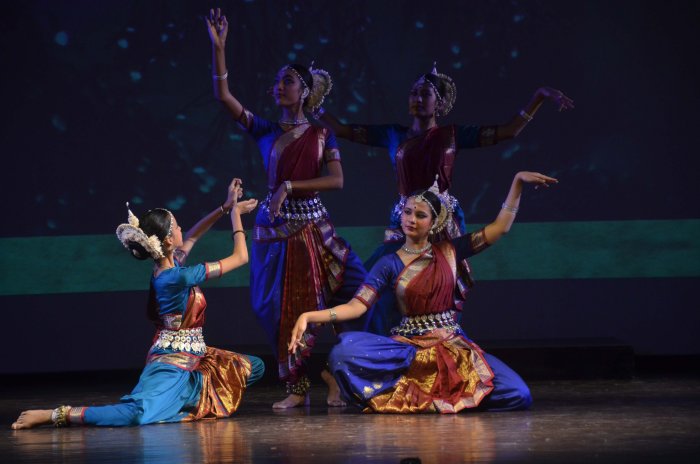 Environment "Environment" - with sounds from Nature in Gurukul, and utterances of animals and birds that follow these sounds -- is among the most inspired part of the programme -- like 'dhalang' for a lion's leap; 'jhijhikita' for the crickets; 'jhanak jhanak' for sound of ghungroos; the little bird's quest for water to quench her thirst after the rains; and so on. A male/female duo does a wonderful job of mimicking, followed by the Jalabindu song in Sanskrit sung with Odissi. "Design" is yet another delightful segment, with multiple ways of designing and redesigning space and time, and numerous ways the body can be used. An example is Matraa as the smallest unit and Bols come as symbolic structures as the building blocks, creating designs with rhythms. The dancers execute Tihais showing Gopuchcha and various Yatis on stage. "Communication" is yet another striking part in a long programme, highlighting verbal, non-verbal, interpersonal and intrapersonal aspects. With a popular Odissi composition Pratibimb (Reflection), three female dancers look into a mythical mirror using many motifs of a Pallavi in raga Jog showcasing all the four motifs fascinatingly. "Anatomy" follows, with the narrative highlighting limbs, joints, flex, stretch, twist, compress, et al. Dancers show preparation of the body through warm-ups, cool downs, stretches, healings... By far, the most fascinating part is "Architecture", with its wealth of illustrations from temple sculpture where the architect visualized it as a human form. A solo Odissi dancer presenting Mangalacharan enters with a unique Chali suggesting the idea of climbing steps in a sacred space. The full turn of the dancer marks the Nandi Mandapa and presenting the Bhoomi Pranam, points at the deities of Jagannath, Subhadra and Balabhadra. After offering Pushpanjali, she defines the arches in the eight directions and the imaginary arches. The dancer concludes with Trikhandi Pranam and the coordinates -- pointed at and defined by the dancer -- creates a virtual architecture out of Shoonya (the empty space). "Arithmetic" comes then, and the idea of aligning a rhythmic phrase in various speeds and multiples (as in Kathak) is just the beginning of the idea of arithmetic. Tihai is a composition that has calculations differing for odd numbers, even numbers, prime numbers. Tihai has many variants - Farmaishi Chakradhaar, Kamali and so on, making 'dha' as a determinant for various segments. "Metaphysics" as a branch of philosophy dealing with nature of existence, truth and knowledge, is then taken up by three Odissi dancers to illustrate how dance can be continually renewed by creation of new movements. The narrative continues: Art is not something separate from the "being" of the artist, but it is the quintessence of her existence, manifest through a skillful practice of her art. In this practice, the two extreme states of existence - spirit and matter generally perceived as opposed to each other - completely coalesce under the harmony of body, mind and spirit. For "neurology", the narrative brings out how dance induces subtle changes in the brain through a process known as plasticity, which induces the brain to adapt in response to experiences. While many elements of a rich narrative cannot be illustrated by a full performance due to sheer pressure of time, they are simply given as a demonstration. "Aesthetics" and "sculpture" are, however, beautifully illustrated with the cyclorama lit up by magnificent visuals of temple friezes and human figures sketched by early Indian and Italian painters, while three Odissi and three Kathak dancers evince their skills, vibrant with movement, rhythm and expression. The interaction of the movement structures and interrelationships of the components of the dance are captured in a Jhaptal Tarana that highlight the aesthetic beauty of Kathak, while Odissi presents excerpts from Batu Nritya highlighting the sculptural poses of Odisha temples through various Bhangis like Mardala, Parshva Mardala, Alasa, Darpani... "Painting" narrates how both space and time act as a canvas to the dancer while the dancer traces various strokes, shapes, forms in both space and time. She creates cadences of painting through lines and colours of emotion and energy through synergy of forms. "Calligraphy" brings out, in the narrative, how the script of Maheshwara Sutra was created by notating Shiva's crescent-like movements as he danced holding damaru in one hand. Dance is the mother of the art of writing. Since calligraphy is an art of creative arrangement of letters, the performative art of dance has an element of spontaneity at its core. For both, the finished product seems fluid and random, but, in reality, each part - even a single stroke - is choreographed, intentionally made. In both, fluid lines seem to mimic the energy and appearance of Nature: the constructed line is no less true than the natural one. Finally, each word in a finished piece is self-contained, an independent spatial experience; similarly, for dance, space is a static condition whereas spacing is an active process. Parwati herself takes the stage and her Kathak performance - based on excerpts from Varnajaa -is superbly dignified. "Nourishment / well-being" talks about nourishment of body, mind, soul, while dance stimulates metabolism, cardio-vascular and neuro-muscular activities. "Yoga" is chitta-vritti-nirodha, whereas dance is Yoga itself. Indeed, Natya Shastra invokes Shiva as the ultimate dancer and Paramayogi. "Immunology" relates to Sattva, Raja, Tama... away from toxic thoughts and polluting ideas. These disciplines are only touched upon. 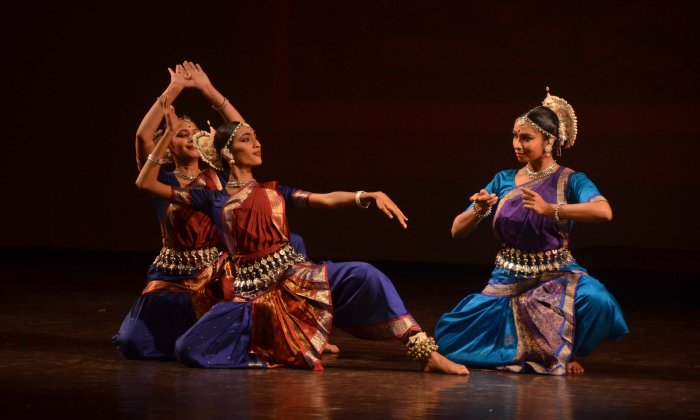 Mythology "Mythology" climbs to rare heights, representing power and divinity through dancing forms. Five Odissi dancers depict Shiva as the cosmic dancer, with his four arms and flying locks symbolizing a multitude of ideas. The idea of creation and destruction of the cosmos is symbolically and metaphorically narrated through legends that form the foundation of dance offerings, guiding the society towards righteousness. The great mythology of Dashavatar is enacted in full in Odissi. 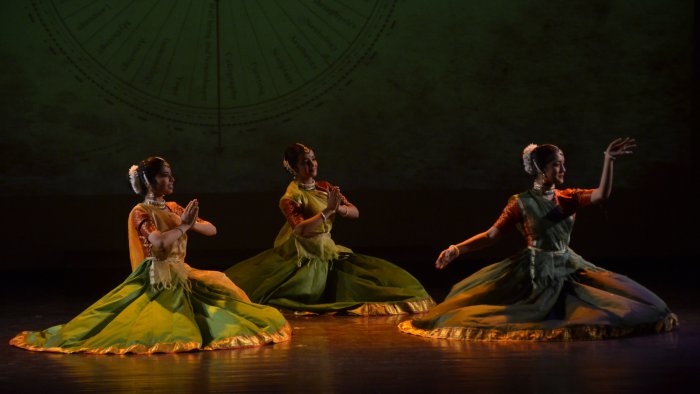 Poetics in dance 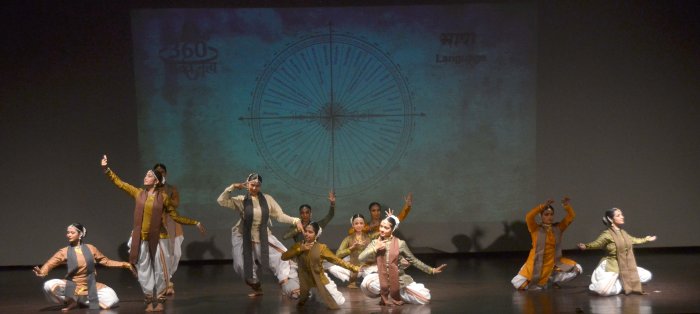 Dance as Language "Literature / Poetics" comes next, depicting excerpts from Chitra Kavya and Vilom Kavya. "Dramatics", the oldest way of looking at dance is taken up next, with performance from Kalidasa's Ritusamhara, bringing out elements of drama. "Language" follows, illustrating how a dance tradition is equipped with codified gestures around which a world of movement language is created. Some examples are enacted from Abhinaya Darpana on Hasta, Shira, Griba, followed by words, phrases, sentences depicted in dance language.  Hasta abhinaya 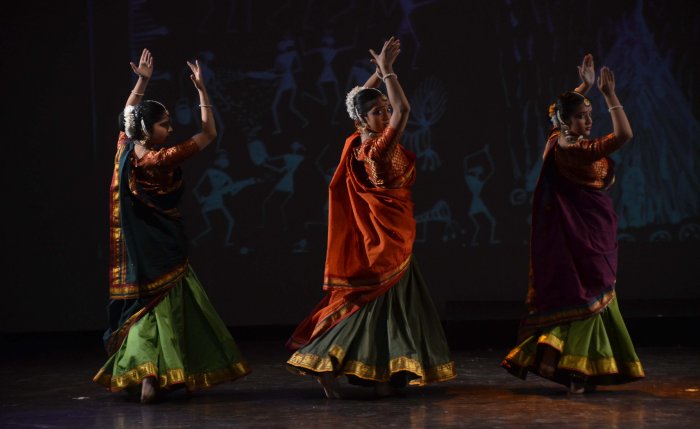 Ovi of Maharashtra Then comes "Sociology". For primitive peoples, dance was their principal form of communication: not merely as corporeal movement, but also for connecting the humans to their gods. Dance represents the symbols and meanings of how social groups live. Jaatyavarch Ovi sung by village women while performing daily chores was presented in Kathak. "Value Education" follows, where dance plays an important role in instilling values in the learners in an oblique way. Dancers present an excerpt from the earlier Mahagami production Sutra Atman, dedicated to Mahatma Gandhi, depicting 11 resolutions of Gandhiji that he followed in his struggle for awakening the country. "Vadya Kala" is an endeavour where the dancer - with her body as the medium and ghungroo as the instruments - weaves various footwork patterns in Kathak to represent the idea of dance as music; dance as melody; dance as Vadya. "Archaeology" comes as a reminder that a dance practitioner is a museum of her own art form, where she has acquired, imbibed and simulated a huge body of work, compositions, aesthetic sensibilities, historical facts and traditional knowledge. She needs to value archaeological facts and details with respect to ancient cultures, civilizational symbols and, importantly, information related to dance embedded in ancient inscriptions and artifacts. There is no performance on this topic and on "Management / Administration" that follows next as narrative. Dance represents dynamics and change, and puts the moving body at the centre of activities, which is ignored in the traditional management theory. Yet, 'Leadership' as a quality and as a dialogue is essential in the work of dancers and musicians who happen to manage groups without words.  Spirituality in dance "Musicology" rings out, without a performance, how dance incorporates a detailed insight into music traditions, music practices and musicology. It is interesting to note that Sharangadeva, in his treatise Sangeet Ratnakar, defines Sangeet as a composite term representing music, instruments and dance. In "Heritage" too, there is no performance, yet the narrative is eloquent as to how dance is one of the few art forms that simultaneously embellish space and time. Last of all, "Spirituality" is treated at length. Dance is an intrinsic part of human nature, being able to offer, to communicate, to connect and to elevate one's consciousness. Vallabacharya's Madhurashtakam is taken up in Kathak to glorify many forms of the sublime Krishna. An Odissi composition Om Manipadme Hum - based on Tibetan Buddhist chant -concludes the evening, seeking to sanctify the space around and within. Overall, it is a marathon programme to cover something like 36 disciplines of knowledge systems found around 360 degrees of gazing around! Hats off to the director for her bravery, consummate devotion to artistry and, above all, a near Spartan daredevilry in attempting to be so comprehensive!!  Dr. Utpal K Banerjee is a scholar-commentator on performing arts over last four decades. He has authored 23 books on Indian art and culture, and 10 on Tagore studies. He served IGNCA as National Project Director, was a Tagore Research Scholar and is recipient of Padma Shri. Post your comments Pl provide your name and email id along with your comment. All appropriate comments posted with name and email id in the blog will also be featured in the site. |